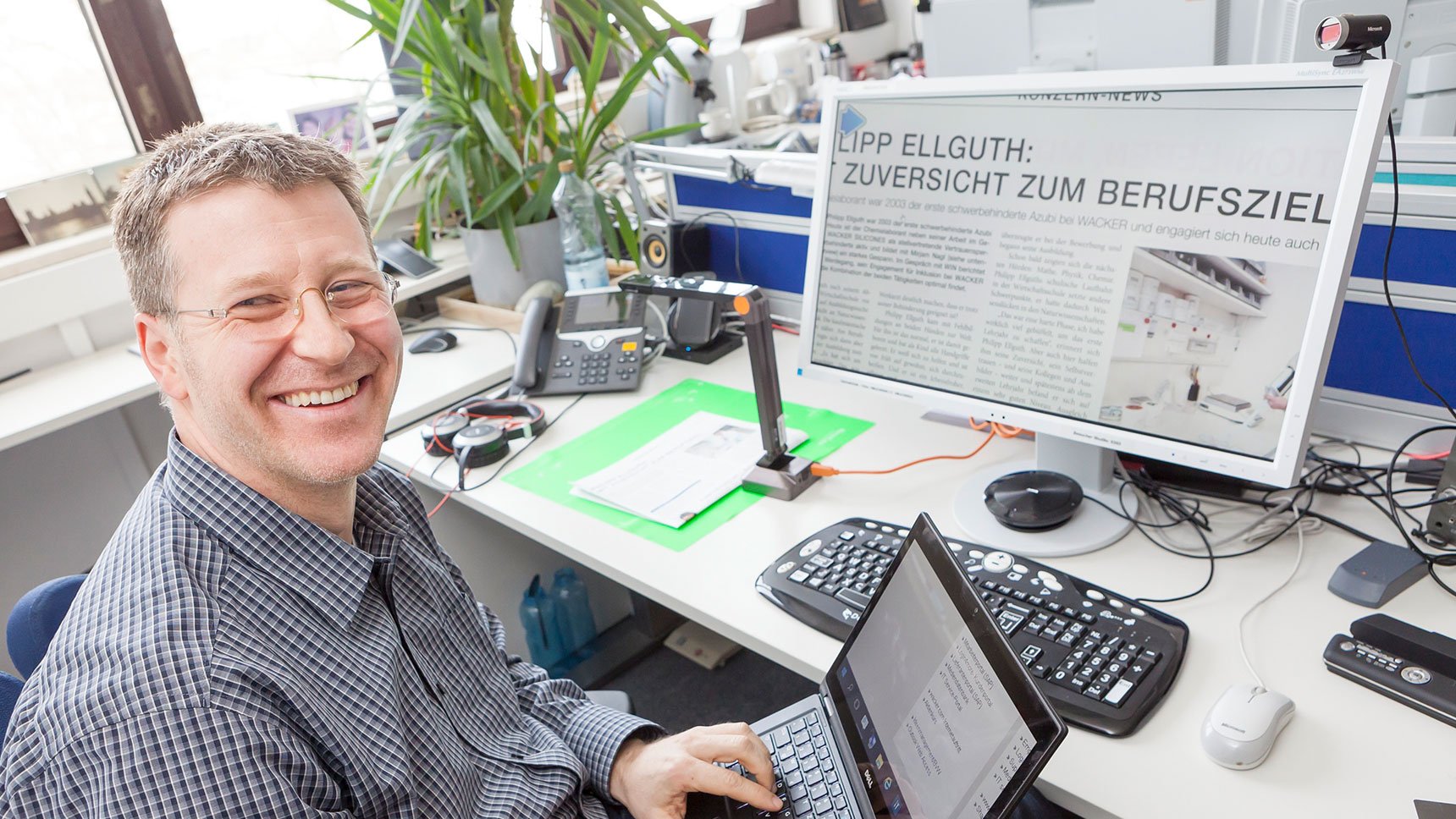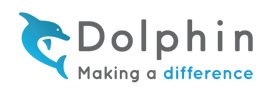Interview with Stefan Kaiser, senior IT systems engineer and Dolphin SuperNova user.
As a senior IT systems engineer for an international employer, Stefan Kaiser has proven expertise in technology systems, and a personal interest in accessibility. We asked him about his experiences and the things that led him to choose and recommend SuperNova for himself and his colleagues.

Tell us about your career in IT
I have worked for WACKER since 1990. I started my career as a trainee. In Germany it is common to get an overview for 3 years, working in the different departments of a company. During this trainee phase I had a big 20 inch Monitor – it was very heavy – around 25 kg. I was the first visually impaired employee at WACKER. So the company really supported me to start my job and have continued to support me during my whole career. After I finished the trainee program I worked for different departments in the human resource unit.
Computers were always a hobby of mine, and colleagues in the HR department used to come to me to get support. In 1997 I got the chance to officially join the IT department and I’ve worked there ever since, starting with user support via phone or on-site. Later we standardised our IT lifecycle processes and I became a member of this team.
I took great interest in setting up these IT processes in both our main production site here in Burghausen, in upper Bavaria and in our headquarters in Munich. I have also visited Japan and China to help support colleagues there.
What is your role there?
Now I act as an IT System engineer in the client development team of the IT department. I have quite a few responsibilities. The main business currently is the global coordination of the W10 migration from our work place computers. I am part of a small team that do IT support for our board members and last but not least, I am responsible for the IT equipment and workplaces for our blind and visual impaired colleagues.
How important is your computer to your role?
Without a computer it is not possible to do anything these days. Computers are everywhere in our life.
There’s been a big change in technology development for blind and visual impaired people in recent years, which is great.
Can you tell us about your visual impairment?
I was born blind in 1973. My parents realised I didn’t recognise any light, so they took me to a specialist eye doctor. The diagnosis was Cataracts and Nystagmus on both eyes. At the age of 3 months, my lenses were removed in an operation and I’ve worn glasses ever since.
My sight level with glasses is between 5 to 10 percent. Since 2003 I have Glaucoma, too. When people ask me 'how is your sight and what do you see?' I tell them it's like looking through the wrong end of a telescope. You see everything, but far away.
I can see everything but not in detail, so I see people, but not their faces, gestures or expressions.
You have invested time into researching assistive technology solutions and have become an expert in this field.
What do you advise people to consider when choosing their own AT solution?
In our company, we first try to find a solution with standard IT equipment. This makes it easier to service.
We also consider the price. While there is a market for gadgets, tools and products for people with disabilities - these are not always specific to blind or visually impaired people. So I usually find that when tech solutions are made for people who are blind, the price is higher than for the rest.
In my own case, the previously available solutions for a mobile workplace were a heavy 19-inch Notebook plus a bulky camera system. The camera itself cost around €4000 and so for me as an IT expert, that situation was not ok. So I started researching to find a way to help myself and my visually impaired colleagues.
Why did you choose Dolphin SuperNova?
Well, SuperNova has one outstanding element of functionality which is the intuitive touch control. On a mobile tablet or the all-in-one PC which we use, this gives us an extra option for control.
Other competitors have this function, but not in the same easy and intuitive way which we are familiar with from Android and iOS tablets. It’s easy with SuperNova to pinch to zoom in and out.
Which SuperNova features do you find most useful?
SuperNova is easy to control. I like to use the three-finger gesture to turn it on and off.
I use the speech/reading function and have found it helpful with longer text. I like that I can let the computer read and I just listen. Not to forget SuperNova has the flexibility to customise your own keyboard combinations for controlling the different functions. I like that a lot.
How does assistive technology help you do your job?
Since I started using SuperNova screen magnification, I can sit in a normal relaxed position. For years before that I had a poor sitting and working posture. My eyes aren't so tired now on hard business days.
Before I used SuperNova magnification, I had problems with my back due to my sitting position at work. This is now gone, as with the screen magnification, the distance between me and my monitor is the same as for colleagues with normal sight.
I use the magnification to compensate for my poor eyesight instead of having to move my body. When I use text or mail editing tools, I like to use the SuperNova focus highlighting function, to find the cursor or the line I am on.
What key advice would you give to employers when they consider computer accommodations and assistive technology for their staff?
It is important to company culture that employees with restrictions are regarded as equivalent employees. When an employee is given personal opportunities and all the technical possibilities they need to fulfil their tasks, they feel like an important part of the company, not the spare wheel. In mine and my colleagues’ experience, I can confirm that inclusion works.
It is also up to each of us not to bury our heads in the sand, but to look ahead.
Everyone has their strengths and they have to be found and supported with the appropriate technical possibilities.
This may be a standard solution with a regular PC and a document camera and screen magnification. It may be a special hardware solution with braille keyboard or one-handed keyboard and screen reader. The market is there and companies or individuals can use the internet to get help if there isn't an expert in your company.
Many senior managers think that assistive technology is not necessary or is too expensive, but to provide the opportunity for employees with visual impairments to work to their full potential will pay back any spend.
The things blind or visually impaired employees can actually achieve at their workstation can be demonstrated to their colleagues with some simple computing tasks. I suggest you get yourself a pair of simulation glasses - and attempt to complete the same tasks on your computer. With the illustration of the problem, some managers then decide differently, that the expense of assistive technology is worth the money.
As disability can affect any one of us, whether in top management or in a junior position, you need to consider the worth of supporting all employees to achieve all of their potential.
You can do this easily with an assistive technology solution such as a screen magnifier with a document camera.
What advice would you give someone who is trying SuperNova for the first time?
First, consider what functions you will use.
Magnification: practice zooming in and zooming out, the overview window, and how to turn magnification on and off.
Start with these functions then check if the pre-configured keyboard shortcuts suit you. If not, you can change them to your own requirements. I use the shortcuts CTRL and the mouse wheel for zoom in and out and CTRL + ENTER to turn magnification on and off.
Secondly, find useful functions. Things like changing the colour in different applications, I tried a few different ones to find the settings that suited me.
Finally, use the SuperNova video tutorials provided on the Dolphin website. You can train at your own pace and train well.

SuperNova is more than just a screen reader. It's a range of assistive technology solutions for use on Windows tablets, laptops and desktop computers. For businesses, remote access for Citrix and Desktop Services are also available.
SuperNova suits many different types of visual impairment as it is available in three editions. These enable users to choose a suitable combination of magnification, colours, speech and braille to suit their vision.
Dolphin also offers SuperNova packages that include SuperNova software set up on a laptop or desktop PC. These are set up, tested, delivered and are ready to use straight from the box.



Let Us Know What You Thought about this Post.
Write your comment below.